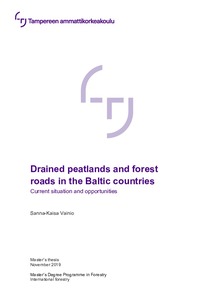Drained peatlands and forest roads in the Baltic countries : Current situation and opportunities
Vainio, Sanna-Kaisa (2019)
Vainio, Sanna-Kaisa
2019
All rights reserved. This publication is copyrighted. You may download, display and print it for Your own personal use. Commercial use is prohibited.
Julkaisun pysyvä osoite on
https://urn.fi/URN:NBN:fi:amk-2019121326581
https://urn.fi/URN:NBN:fi:amk-2019121326581
Tiivistelmä
In Finland there is a wide networks of forest ditches and roads. The level of knowledge concerning maintaining and renovation involving ditches and roads projects is high in Finland. The aim of this thesis is to research how similar projects are managed in the Baltic countries and whether there are opportunities for a Finnish service provider in the Baltic area.
The research was implemented as an interview. The aim was to interview three specialists from every Baltic country, so that they present three different views of the public forest sector of the respective country. However, due to lack of resources and language issues, only one interview from each country was conducted and so the results ended up being narrower than initially assumed. The interviews are supplemented with literature review to gain more information about the situation in the Baltic forests.
In Estonia the system for managing and maintaining the drained peatlands is good. It seems that the density of forest roads could be higher especially in the sector of private owners. There could be opportunities in both ditch and road project for a Finnish service provider in Estonia.
In Latvia and Lithuania the forests are strictly maintained under the FCS-certification. It needs to be taken into account if heading there. In Latvia the situation with drained peatland seems to be good and in Lithuania there is very small ditch network. Also, forest road density seems to be good, but the condition would need upgrading, especially in Lithuania. There is no point in taking part in the drainage projects in Lithuania and in more research would be necessary to clarify the opportunities for profitably exporting Finnish knowhow to Latvia and Lithuania.
Because of the difficulties in collecting sufficient information the results of this thesis need to be taken as suggestions only.
The research was implemented as an interview. The aim was to interview three specialists from every Baltic country, so that they present three different views of the public forest sector of the respective country. However, due to lack of resources and language issues, only one interview from each country was conducted and so the results ended up being narrower than initially assumed. The interviews are supplemented with literature review to gain more information about the situation in the Baltic forests.
In Estonia the system for managing and maintaining the drained peatlands is good. It seems that the density of forest roads could be higher especially in the sector of private owners. There could be opportunities in both ditch and road project for a Finnish service provider in Estonia.
In Latvia and Lithuania the forests are strictly maintained under the FCS-certification. It needs to be taken into account if heading there. In Latvia the situation with drained peatland seems to be good and in Lithuania there is very small ditch network. Also, forest road density seems to be good, but the condition would need upgrading, especially in Lithuania. There is no point in taking part in the drainage projects in Lithuania and in more research would be necessary to clarify the opportunities for profitably exporting Finnish knowhow to Latvia and Lithuania.
Because of the difficulties in collecting sufficient information the results of this thesis need to be taken as suggestions only.
